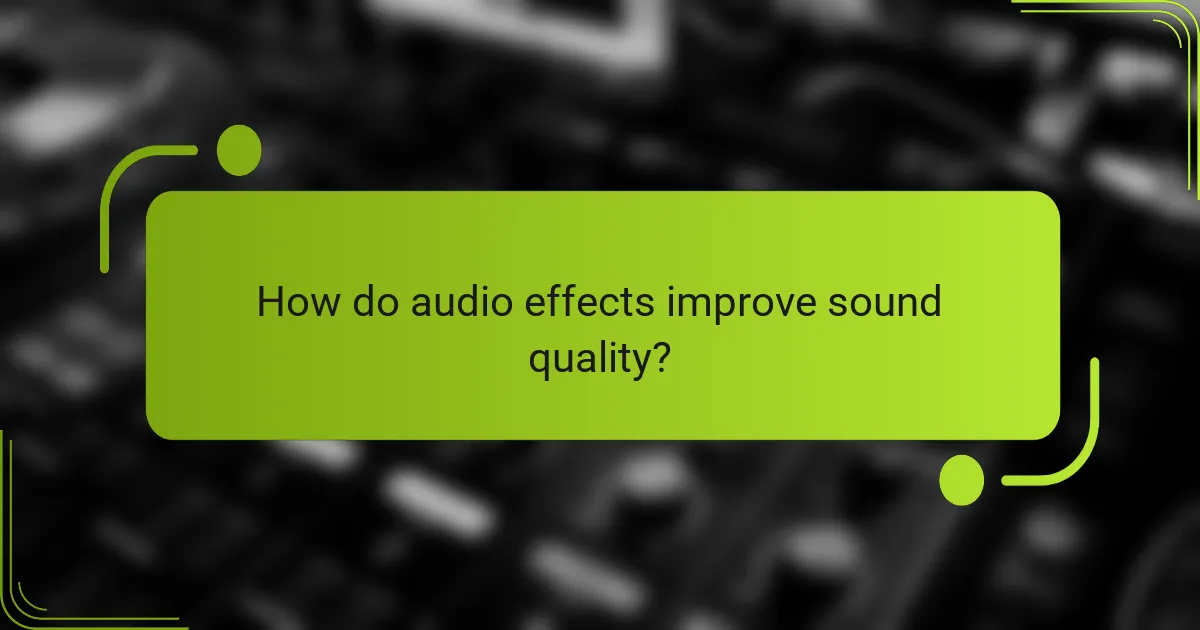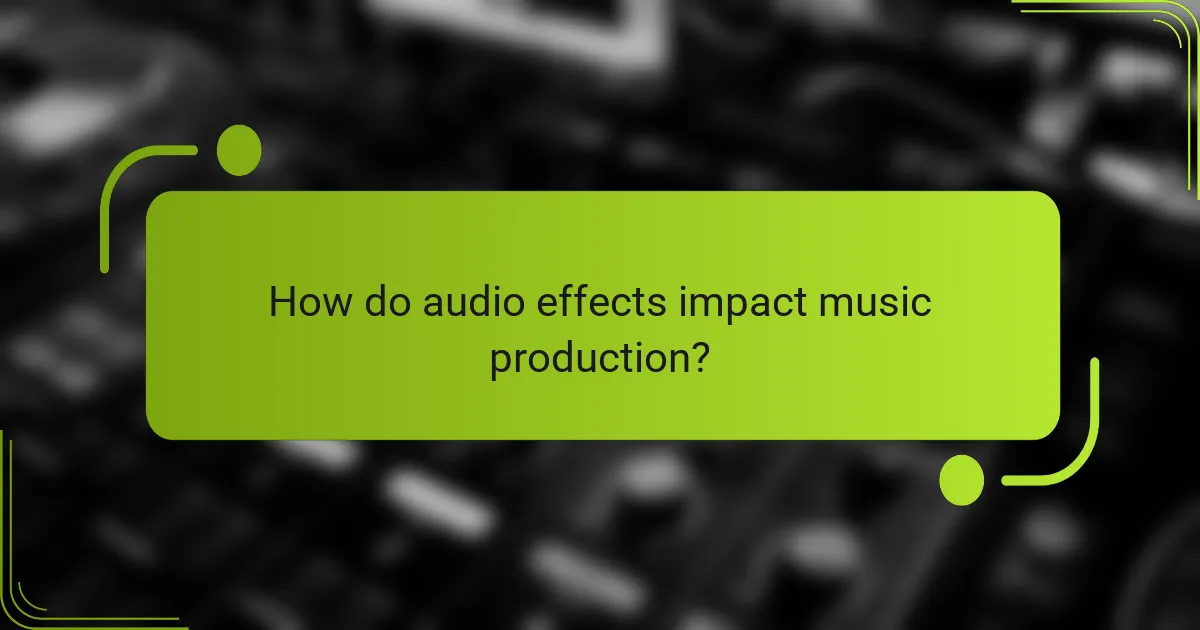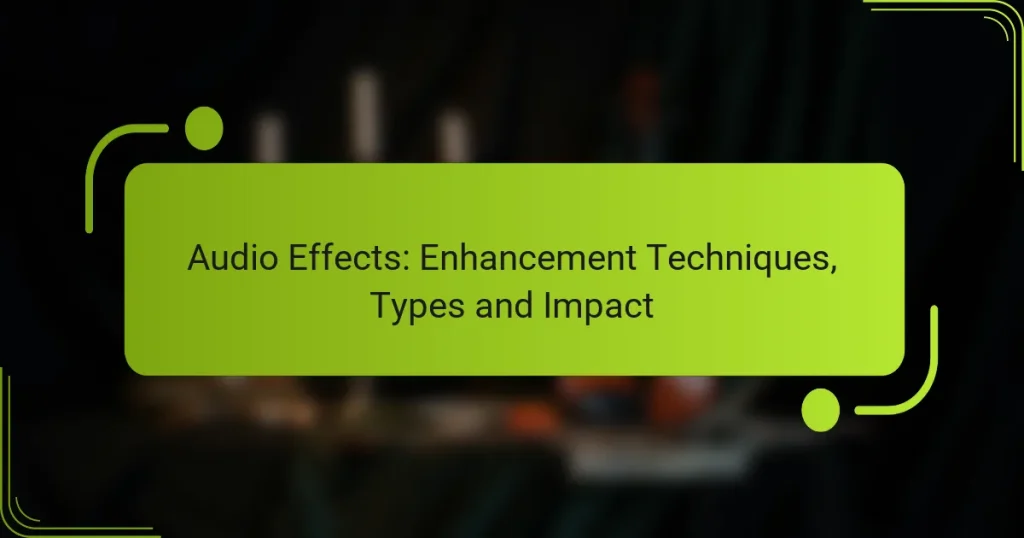Audio enhancement techniques play a crucial role in improving sound quality and creating a more engaging listening experience. By utilizing effects such as equalization, compression, and reverb, audio professionals can clarify sounds, control dynamics, and add depth to recordings. Understanding the various types of audio effects is essential for selecting the appropriate tools to achieve the desired impact in any audio project.

What are the best audio enhancement techniques?
The best audio enhancement techniques include equalization, compression, reverb, chorus, and noise reduction. Each technique serves a specific purpose in improving sound quality, making recordings clearer and more engaging.
Equalization
Equalization (EQ) adjusts the balance of different frequency components in audio. By boosting or cutting specific frequency ranges, you can enhance clarity, remove muddiness, or add warmth to a sound. For example, cutting frequencies around 200-400 Hz can reduce muddiness, while boosting around 3-5 kHz can enhance vocal presence.
When using EQ, consider the context of the audio. For instance, a vocal track may require different EQ settings than a bass guitar. A common pitfall is over-equalizing, which can lead to unnatural sound. Aim for subtle adjustments to maintain a natural tone.
Compression
Compression reduces the dynamic range of audio, making quiet sounds louder and loud sounds quieter. This technique helps maintain a consistent volume level, which is crucial for professional-sounding recordings. A typical compression ratio might range from 2:1 to 4:1, depending on the material.
Be mindful of attack and release settings; a fast attack can catch peaks but may also squash the sound’s natural dynamics. Avoid excessive compression, as it can lead to a lifeless sound. Use compression judiciously to enhance clarity without sacrificing expressiveness.
Reverb
Reverb adds a sense of space and depth to audio by simulating the natural reflections of sound in an environment. It can make recordings feel more immersive and polished. Different types of reverb, such as hall, room, or plate, can create varied atmospheres.
When applying reverb, consider the size of the space you want to emulate. A small room reverb may suit vocals, while a large hall reverb works well for orchestral music. Overusing reverb can muddy the mix, so aim for a balanced application that enhances without overwhelming.
Chorus
Chorus creates a richer sound by layering multiple slightly delayed copies of the original audio signal. This effect can make a single instrument or vocal sound fuller and more vibrant. The depth and rate settings control how pronounced the effect is, with moderate settings often yielding the best results.
Chorus is particularly effective on guitars and vocals, but excessive use can lead to a washed-out sound. Use it sparingly to enhance the audio without losing clarity. A good rule of thumb is to keep the depth low and the rate moderate for a natural feel.
Noise Reduction
Noise reduction techniques aim to eliminate unwanted background noise from recordings, such as hum, hiss, or ambient sounds. This can significantly improve the clarity of audio, especially in dialogue or vocal tracks. Tools like noise gates and spectral editing can be effective in this process.
When applying noise reduction, be cautious not to remove too much of the desired signal, as this can lead to artifacts or a hollow sound. A common approach is to sample the noise profile and apply reduction selectively. Regularly monitor the audio to ensure the integrity of the original sound is maintained.

How do audio effects improve sound quality?
Audio effects enhance sound quality by modifying various aspects of the audio signal, resulting in a more polished and engaging listening experience. These effects can clarify sounds, control dynamics, and create a sense of space, ultimately making the audio more enjoyable and impactful.
Clarity and Definition
Clarity in audio refers to the distinctness of sounds, allowing listeners to easily discern individual elements within a mix. Effects such as equalization (EQ) can boost or cut specific frequency ranges, helping to eliminate muddiness and enhance vocal intelligibility. For instance, reducing low frequencies while slightly boosting mid-range frequencies can significantly improve clarity in vocal tracks.
Using compression can also aid in definition by controlling the dynamic range, ensuring that softer sounds are audible while preventing louder sounds from becoming overwhelming. This balance allows for a more cohesive sound that maintains clarity across various playback systems.
Dynamic Range Control
Dynamic range control involves managing the difference between the quietest and loudest parts of an audio signal. This is crucial for maintaining a consistent listening experience, especially in genres like pop or rock where volume fluctuations can be pronounced. Compression is a common technique used to reduce dynamic range, allowing quieter sounds to be heard without distortion from louder peaks.
When applying dynamic range control, it’s important to avoid over-compression, which can lead to a lifeless sound. A good rule of thumb is to aim for a dynamic range that allows for some peaks while keeping the overall level consistent, typically around 6 to 10 dB of reduction for most applications.
Spatial Effects
Spatial effects create a sense of space and depth in audio, making it feel more immersive. Techniques such as reverb and delay simulate the natural acoustics of different environments, allowing sounds to blend seamlessly. For example, adding a subtle reverb to a vocal track can make it feel as though it’s being performed in a larger space, enhancing the overall experience.
When using spatial effects, consider the context of the audio. Too much reverb can muddy a mix, while too little can make it sound flat. A practical approach is to start with a small amount of reverb and gradually increase it until the desired ambiance is achieved, typically aiming for a balance that complements the other elements in the mix.

What types of audio effects are commonly used?
Common audio effects include time-based, dynamic, and distortion effects, each serving distinct purposes in sound enhancement. Understanding these types helps in selecting the right effect for specific audio projects.
Time-Based Effects
Time-based effects manipulate the timing of audio signals to create depth and space. Common examples include reverb, delay, and chorus, which can add richness to a sound by simulating different environments or creating echoes.
When using time-based effects, consider the tempo of the music and the desired atmosphere. For instance, a short delay can add a sense of immediacy, while a longer reverb can create a spacious, ambient feel. Aim for subtlety to avoid overwhelming the original sound.
Dynamic Effects
Dynamic effects control the amplitude of audio signals, affecting their loudness and overall presence. Compression, expansion, and gating are typical dynamic effects that help balance audio levels and enhance clarity.
Using dynamic effects requires careful adjustment of thresholds and ratios to avoid unwanted artifacts. For example, moderate compression can smooth out vocal performances, while excessive compression may lead to a lifeless sound. Always listen critically to ensure the effect enhances rather than detracts from the audio.
Distortion Effects
Distortion effects alter the audio signal to create a more aggressive or textured sound. Common types include overdrive, fuzz, and bit-crushing, often used in genres like rock and electronic music to add character and intensity.
When applying distortion, consider the type of distortion that best suits your audio. Overdrive can add warmth, while bit-crushing can produce a gritty, lo-fi effect. Use these effects sparingly to maintain the integrity of the original sound and avoid muddiness.

How do audio effects impact music production?
Audio effects significantly enhance music production by shaping sound quality, adding depth, and creating a more engaging listening experience. They can transform raw recordings into polished tracks, influencing everything from the emotional tone to the clarity of individual instruments.
Enhancing Listener Experience
Audio effects play a crucial role in enhancing the listener experience by creating immersive soundscapes. Techniques such as reverb and delay can simulate environments, making the music feel more expansive and alive. For instance, a subtle reverb can give vocals a sense of space, while a well-placed delay can add rhythmic interest.
When applying effects, consider the genre and target audience. For example, electronic music often benefits from pronounced effects, while acoustic genres may require a more subtle approach. Striking the right balance is key to maintaining listener engagement.
Creative Sound Design
Creative sound design utilizes audio effects to craft unique sonic identities. Effects like distortion, modulation, and filtering can transform ordinary sounds into extraordinary textures. For example, using a phaser can create a swirling effect that adds movement to a static sound.
Experimentation is essential in sound design. Try layering different effects or adjusting parameters to discover new sounds. Keep in mind that less is often more; over-processing can lead to muddiness, detracting from the overall quality.
Mixing and Mastering Efficiency
In mixing and mastering, audio effects streamline the process and enhance the final product. Tools like compression and equalization help balance levels and frequency ranges, ensuring clarity across all elements of a track. For instance, using a compressor can control dynamic range, making quieter sounds more audible without overwhelming louder ones.
To improve efficiency, establish a consistent workflow with your effects. Create templates for different genres or styles, and use presets as starting points. This approach can save time and help maintain a cohesive sound throughout the production process.

What are the prerequisites for using audio effects?
To effectively use audio effects, a basic understanding of sound principles and the tools available is essential. Familiarity with audio editing software and hardware can significantly enhance the quality and creativity of your audio projects.
Understanding Sound Fundamentals
Sound is a wave that travels through air (or other mediums) and is characterized by its frequency, amplitude, and waveform. Understanding these fundamentals is crucial when applying audio effects, as they directly influence how the effects will alter the sound. For instance, frequency affects pitch, while amplitude relates to volume.
When applying effects like equalization or compression, knowing the sound’s frequency range helps in making informed adjustments. For example, vocals typically occupy a frequency range of 85 Hz to 255 Hz, while a kick drum might range from 60 Hz to 100 Hz. Tailoring effects to these ranges can enhance clarity and impact.
Common pitfalls include over-processing audio, which can lead to distortion or loss of natural sound. A good practice is to apply effects gradually and listen critically to ensure the sound remains balanced and true to its original character.

